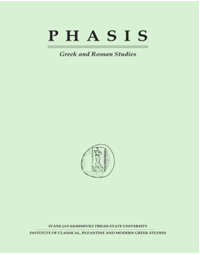Phasian Confusion. Notes on Kolchian, Armenian and Pontic River Names in Myth, History and Geography
DOI:
https://doi.org/10.48614/phasis.21.2019.73-118Abstract
Due to its close link with the legendary kingdom of Aia, where the Argonauts found the Golden Fleece, the Kolchian Phasis is one of the most illustrious rivers in world literature. It is, at the same time, surrounded by several controversies, ancient as well as modern. The evidence seems to suggest that it was first pictured as part of the mythical landscape around 500 B.C. Mythical narratives, colonial ideologies, reports of explorers and geographical speculation led to a heterogeneous, in part fancy tradition, as is best exemplified by the Phasis/Tanaïs/Don, which was fathomed with a second outlet into the Baltic Sea. This notwithstanding, the concept of the Kolchian Phasis was quite sober. Eratosthenes, Strabo and the mainstream literary tradition identified it with the modern Rioni only as far as Rhodopolis/Geguti, whence its middle course equals the Kvirila River to Sarapana/Shoropani; its upper course, now the Barimela, connected it with its Armenian source. The knowledge that Herodotos and Xenophon had of the Phasis/Rioni and of the Araxes/Phasis/Aras was limited but not confused. Prokopios, however, describes the Boas/Akampsis as the upper course of the Phasis/Kvirila/Rioni in Book 2, but corrects this view in Book 8. His error stands in a broader tradition that ignored the Akampsis, possibly due to confusion with multiple rivers called Lykoi in the Argonautic and geographical literature. This insight will allow us to demystify Apollonios Rhodios’ verses on the Phasis, Lykos and Araxes, and to appreciate the minor rivers of the riverscape of Aia: the Hippos, Kyaneos, Glaukos and Lykos, whose systematic study remains a desideratum.Downloads
Published
2019-12-16
Issue
Section
Articles
License
Copyright (c) 2019 PHASIS

This work is licensed under a Creative Commons Attribution-NonCommercial 4.0 International License.


